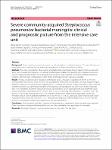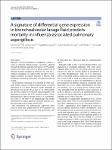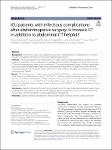Search
Author
- Agostinho, Carvalho (1)
- Amazigh, Aguersif (1)
- Amélie, Renou (1)
- André, Oliveira (1)
- next >
Subject
- abdominopelvic surgery (1)
- available sophisticate... (1)
- community-acquired pne... (1)
- endotracheal tube (1)
- next >
Date issued
- 2023 (8)
Has File(s)
- true (8)
Search Results
Severe community-acquired pneumococcal meningitis is a medical emergency. The aim of the present investigation was to evaluate the epidemiology, management and outcomes of this condition. |
Impaired consciousness is common in intensive care unit (ICU) patients, and an individual’s degree of consciousness is crucial to determining their care and prognosis. However, there are no methods that continuously monitor consciousness and alert clinicians to changes. We investigated the use of physiological signals collected in the ICU to classify levels of consciousness in critically ill patients. |
Influenza-associated pulmonary aspergillosis (IAPA) is a severe co-infection with the fungus Aspergillus, affecting critically ill influenza patients. Mortality of IAPA patients reaches 45%, more than twice as much as observed in influenza patients admitted to intensive care unit (ICU) without aspergillosis [1]. Importantly, the effect of antifungal treatment on patient outcome is limited, while prognostic biomarkers tailored for this patient group are lacking. |
Lung ultrasonography (LUS) has become an essential component of the evaluation and clinical management of patients admitted to the intensive care unit (ICU). The interpretation of LUS artifact (A- and B-patterns), analysis of the pleura, and the visualization of real images (C pattern) have demonstrated usefulness for the differential diagnosis of acute respiratory failure (ARF) [1]. However, current methods are non-quantitative and have important drawbacks deriving from visually guided assessment of LUS data [2]. Interestingly, recent in vitro and in vivo studies suggest that LUS data carry valuable information that correlates with lung density [2]. |
The aim of this study was to assess the usefulness of adding thoracic CT to abdominal CT in intensive care unit (ICU) patients with signs of infection after abdominopelvic surgery. |
The past years have witnessed dramatic changes in the population admitted to the intensive care unit (ICU). Older and sicker patients are now commonly treated in this setting due to the newly available sophisticated life support. However, the short- and long-term benefit of this strategy is scarcely studied. |
Intensivists target different blood pressure component values to manage intensive care unit (ICU) patients with sepsis. We aimed to evaluate the relationship between individual blood pressure components and organ dysfunction in critically ill septic patients. |
Chest radiographs are routinely performed in intensive care unit (ICU) to confirm the correct position of an endotracheal tube (ETT) relative to the carina. However, their interpretation is often challenging and requires substantial time and expertise. The aim of this study was to propose an externally validated deep learning model with uncertainty quantification and image segmentation for the automated assessment of ETT placement on ICU chest radiographs. |







